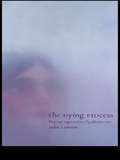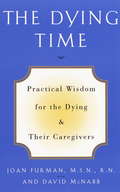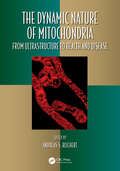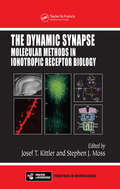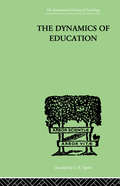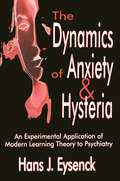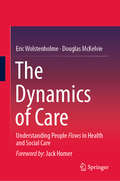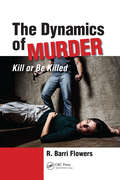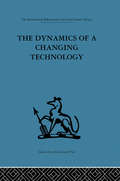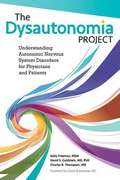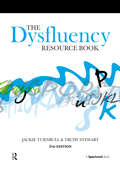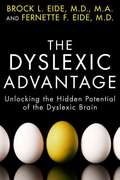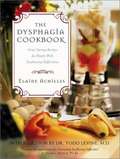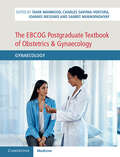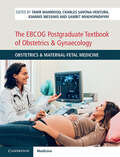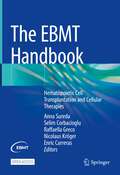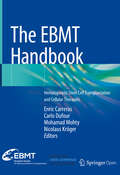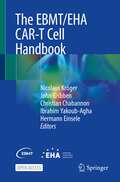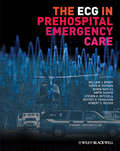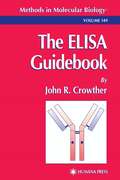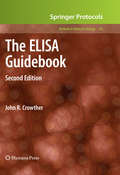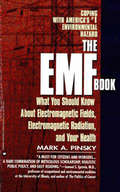- Table View
- List View
The Dying Process: Patients' Experiences of Palliative Care
by Julia LawtonTaking as its focus a highly emotive area of study, The Dying Process draws on the experiences of daycare and hospice patients to provide a forceful new analysis of the period of decline prior to death.Placing the bodily realities of dying very firmly centre stage and questioning the ideology central to the modern hospice movement of enabling patients to 'live until they die', Julia Lawton shows how our concept of a 'good death' is open to interpretation. Her study examines the non-negotiable effects of a patient's bodily deterioration on their sense of self and, in so doing, offers a powerful new perspective in embodiment and emotion in death and dying.A detailed and subtle ethnographic study, The Dying Process engages with a range of deeply complex and ethically contentious issues surrounding the care of dying patients in hospices and elsewhere.
The Dying Time
by Joan Furman David Mcnabb"One of the best books available on caring for the dying, The Dying Time combines deep insight and down-to-earth practicality. All caregivers need to know what's between these covers. This book demystifies the process of death, yet honors the sacredness of life's final transition. Highly recommended." Larry Dossey, M.D., author of Prayer Is Good Medicine"Living until we die can be difficult. This book can guide you through that time. It is practical, spiritual, and filled with wisdom."Bernie S. Siegel, M.D., author of Love, Medicine, and MiraclesHere is a comprehensive and thorough handbook for the dying and their caregivers. Joan Furman and David McNabb walk the reader through the dying time, providing details on how to make the environment conducive to peace and tranquillity, give physical care, understand and respond to the emotional and spiritual crises that naturally occur, and stay healthy as a caregiver. They answer with honesty and sensitivity the questions most frequently asked, such as what actually happens at the time of death. The book also deals with arranging for a meaningful memorial service and handling grief for those who are left behind. And it offers guided imagery for coping with pain and suggests literature and music to ease the passage of those whose health is irreversibly failing.From the Trade Paperback edition.
The Dynamic Nature of Mitochondria: from Ultrastructure to Health and Disease (Oxidative Stress and Disease)
by Andreas S. ReichertMitochondrial research has exploded over the last ~150 years. This book gives an amazing view on a conceptual change in our understanding of mitochondrial biology. It becomes clear that mitochondria are extremely dynamic in nature, controlling life at multiple levels. Mitochondria rule energy conversion, adapt cells well to changing stress and nutrient conditions, and regulate many cellular processes including immunity. The dynamic nature of mitochondria occurs at an intramitochondrial level but also includes its ability to interact with other organelles and to modulate multiple signalling pathways. It is thus not surprising that alterations or inabilities to ensure this dynamic behaviour is linked to ageing and human diseases.The following sections give an updated view on mitochondria: Mitochondrial ultrastructure: molecular mechanisms shaping the inner membrane Mitochondrial cristae and lipid dynamics: from super-resolution microscopy to lipid-OXPHOS interplay Mitochondrial control of cellular homeostasis: from redox signalling to interorganellar contact sites Mitochondria in health and disease: from mtDNA release to Complex I assembly Advanced methods in mitochondrial biology and metabolism research Integrative view on mitochondrial research and outlook The field of mitochondrial research has always been full of surprises and has helped science to advance tremendously. It developed hand in hand with landmark developments in technology, such as super-resolution microscopy (nanoscopy), and is currently influencing an increasing number of scientific disciplines. There is still much ‘new’ to find out about this ‘old’ organelle and I think that you can find interesting and also unexpected aspects of mitochondrial biology in this book. I hope the book will enhance your scientific curiosity and inspire your own research.
The Dynamic Synapse: Molecular Methods in Ionotropic Receptor Biology (Frontiers in Neuroscience)
by Josef T. Kittler Stephen J. MossExploring the diverse tools and technologies used to study synaptic processes, The Dynamic Synapse: Molecular Methods in Ionotropic Receptor Biology delineates techniques, methods, and conceptual advances for studying neurotransmitter receptors and other synaptic proteins. It describes a broad range of molecular, biochemica
The Dynamics Of Education: A METHODOLOGY OF PROGRESSIVE EDUCATIONAL THOUGHT (International Library Of Psychology)
by Taba, HildaFirst published in 1999. Routledge is an imprint of Taylor & Francis, an informa company.
The Dynamics of Anxiety and Hysteria: An Experimental Application of Modern Learning Theory to Psychiatry
by Hans EysenckHere Hans Eysenck applies the principles of modern learning theory to account for the observed phenomena of hysteria and anxiety. Such principles were initially developed through the experiments and theories of Pavlov, Hull, and Tolman. When The Dynamics of Anxiety and Hysteria initially appeared, these were considered the most advanced, relevant, and applicable to the subject matter. They have not been superseded by later work. The Dynamics of Anxiety and Hysteria has never been published in the United States. It was the fifth book Eysenck authored as part of a series of experimental studies and theoretical work carried out under the auspices of the Institute of Psychiatry at the University of London. Two of the first four books-Dimensions of Personality and The Psychology of Politics, have been reissued with new introductions. These focus on dimensional analysis of personality based on experimental and empirical studies. The present work, on the other hand, goes beyond classification to a study of dynamics; from nosology to aetiology; from description to causation. Eysenck scientifically explores such topics as learning theory and human behavior, personality and learning theory; personality and perceptual processes, socialization and personality, drugs and personality, and psychological theory and psychiatric practice. This volume, which complements Transaction's other new editions of Eysenck's groundbreaking work, will be of lasting significance to psychologists, psychiatrists, behavioralists, and students of personality disorders. He provided for modern psychology the empirical foundations of themes that previosly were the monopoly of psychoanalysis. Hans J. Eysenck (1916-1997), a professor of psychology at the University of London and the director of its psychological department at the Institute of Psychiatry, was best known for his experimental researches in the field of personality. He was a prolific author and wrote, among others, Rebel with a Cause, Dimensions of Personality, and Intelligence, all available from Transaction.
The Dynamics of Care: Understanding People Flows in Health and Social Care
by Eric Wolstenholme Douglas McKelvieThis book describes numerous projects which shed light on some of the most persistent issues of the day in health and social care. The work demonstrates the importance of embedding the concept of flow into everyday health and social care thinking and creates insights into patient journeys through different conditions and treatments. It suggests that improving throughput across agencies is the key way to improving the performance of health treatment, whereas increasing capacity is the key way to improving the performance of social care by retaining independent living. The authors conclude that for state-provided care, balancing health and social care provision can eliminate the many stressful fire-fighting strategies hospitals have to undertake when faced with high demands, and this is a win-win scenario in terms of patients, staff and costs. Further, that there is a need for better understanding of the dynamics of population ageing, the dynamics of health conditions and the provision of better, integrated information systems. The book will be a valuable resource for practitioners, clinicians, managers and academics in health, social work, public health and public policy in many countries.In this important book Eric Wolstenholme and Douglas McKelvie bring two lifetimes of award-winning experience in applying system dynamics to improving our very clinically advanced but often dysfunctional care systems.- David F. Andersen, O’Leary Distinguished Service Professor, Emeritus, State University of New York, Albany, USA.Health and social care suffer from some persistent and serious problems which not only undermine well intended care but also impose considerable costs in many societies. This very welcome and exceptional book offers the hope of sound and sustainable solutions to many of these issues. - Kim Warren, Strategy Dynamics, London, UK
The Dynamics of Health and Wellness: A Biopsychosocial Approach
by Judith Green Robert ShellenbergerAn introduction to health and wellness, based on studies of healthy people, which describes the complex processes that are the result of the interaction of biological, psychological, and social systems.
The Dynamics of Murder: Kill or Be Killed
by R. Barri FlowersIn recent years, there has been a surge in school shootings, workplace homicides, hate violence, and deadly terrorist attacks in the United States. This has resulted in a greater focus on homicidal behavior, its antecedents, ways to recognize warning signs of at-risk victims and offenders, and preventive measures. It has also led to increased effor
The Dynamics of a Changing Technology: A case study in textile manufacturing
by Peter J Fensham Dougles HooperTavistock Press was established as a co-operative venture between the Tavistock Institute and Routledge & Kegan Paul (RKP) in the 1950s to produce a series of major contributions across the social sciences. This volume is part of a 2001 reissue of a selection of those important works which have since gone out of print, or are difficult to locate. Published by Routledge, 112 volumes in total are being brought together under the name The International Behavioural and Social Sciences Library: Classics from the Tavistock Press. Reproduced here in facsimile, this volume was originally published in 1964 and is available individually. The collection is also available in a number of themed mini-sets of between 5 and 13 volumes, or as a complete collection.
The Dysautonomia Project: Understanding Autonomic Nervous System Disorders for Patients and Physicians
by Kelly Freeman David S. Goldstein Charles R. ThompsonDysautonomia (Dis-auto-NO-mia) is a general term used to describe any disorder of the autonomic (or automatic nervous) system. These disorders usually involve abnormal symptoms in many organ systems, including cardiac, gastrointestinal, neurological, and pulmonary, as well as others. The book serves as an informational tool to help improve awareness and understanding of dysautonomia for both patients and physicians.
The Dysfluency Resource Book
by Jackie Turnbull Trudy StewartThis is a comprehensive resource book for treating adults who stammer. Completely revised and updated to take account of current practice, this new edition draws together the latest information on therapy for adults along with practical examples of exercises, tasks and activities that can be used for both individual and group programmes. With new chapters and therapy ideas, this is an extremely useful resource for all speech & language therapists and students working with adults who stammer. This useful resource seeks to explain techniques for treating people who stammer and the rationale for their use. This volume forms a catalogue of treatment options from which clinicians may choose to use all of the techniques or pick out particular sections according to their clients' special requirements. The first edition of this book proved to be a very useful tool for speech and language professionals, and this new edition has come about largely because clinicians, speech and language therapists and teachers have requested it. With the inclusion of 50 photocopiable handouts and the presentation of the chapters in the order they would use with their own group programmes, the authors set out the principles of therapy in such a way that the treatment techniques fit into a clear management approach. Trudy Stewart is a specialist in dysfluency and has been a service manager since 1986. She studied in America and obtained her PhD in 1991. Jackie Turnbull retired from SLT in July 2009 after 40 years in the profession, over 35 of which were spent as a specialist in dysfluency, working with children and adults. She also worked for many years as a staff counsellor in a large hospital. The collaboration that has grown up between the two of them has sparked further study in stammering. Together they have developed a highly creative clinical practice which has national recognition.
The Dyslexia Debate
by Elena L. Grigorenko Julian G. ElliottThe Dyslexia Debate examines how we use the term 'dyslexia' and questions its efficacy as a diagnosis. While many believe that a diagnosis of dyslexia will shed light on a reader's struggles and help identify the best form of intervention, Julian G. Elliott and Elena L. Grigorenko show that it adds little value. In fact, our problematic interpretation of the term could prove to be a major disservice to many children with difficulties learning to read. This book outlines in detail the diverse ways in which reading problems have been conceptualized and operationalized. Elliott and Grigorenko consider the latest research in cognitive science, genetics, and neuroscience, and the limitations of these fields in terms of professional action. They then provide a more helpful, scientifically rigorous way to describe the various types of reading difficulties and discuss empirically supported forms of intervention.
The Dyslexic Advantage: Unlocking the Hidden Potential of the Dyslexic Brain
by Brock L. Eide Fernette F. EideTwo neurolearning experts reveal the hidden benefits of having a dyslexic brain. In this paradigm-shifting book, neurolearning experts Drs. Brock and Fernette Eide describe an exciting new brain science that reveals that dyslexic people have unique brain structure and organization. While the differences are responsible for certain challenges with literacy and reading, the dyslexic brain also gives a predisposition to important skills, and special talents. While dyslexics typically struggle to decode the written word, they often also excel in such areas of reasoning as mechanical (required for architects and surgeons), interconnected (artists and inventors); narrative (novelists and lawyers), and dynamic (scientists and business pioneers). The Dyslexic Advantage provides the first complete portrait of dyslexia.
The Dysphagia Cookbook: Great Tasting And Nutritious Recipes For People With Swallowing Difficulties
by Elayne Achilles Todd Levine<P>The Dysphagia Cookbook is a specialty cookbook filled with nutritious, great-tasting recipes for those whose eating options are limited by chewing and swallowing difficulties. <P>All of the recipes focus on enhancing flavor, presentation, texture, aroma, and color, for there are many other products that supply nutritious calories or liquids but give little attention to these quality-of-life concerns.
The EBCOG Postgraduate Textbook of Obstetrics & Gynaecology: Gynaecology
by Tahir Mahmood Sambit Mukhopadhyay Charles Savona Ventura Ioannis MessinisThis authoritative textbook provides a much-needed guide for postgraduate trainees preparing for the European Board and College of Obstetrics and Gynaecology (EBCOG) Fellowship examination. Published in association with EBCOG, it fully addresses the competencies defined by the EBCOG curriculum and builds the clinical practice related to these competencies upon the basic science foundations. Volume 2 covers the depth and breadth of gynaecology, and draws on the specialist knowledge of four highly experienced Editors and over 100 contributors from across Europe, reflecting the high-quality training needed to ensure the safety and quality of healthcare for women. It incorporates key international guidelines throughout, along with colour diagrams and photographs for easy understanding. This is an invaluable resource, not only for postgraduate trainees planning to sit the EFOG examination, but also for practising specialists looking to update their knowledge and skills to meet the ever-evolving complexity of clinical practice.
The EBCOG Postgraduate Textbook of Obstetrics & Gynaecology: Obstetrics & Maternal-Fetal Medicine
by Tahir Mahmood Sambit Mukhopadhyay Ioannis Messinis Charles Savona-VenturaThis authoritative textbook provides a much-needed guide for postgraduate trainees preparing for the European Board and College of Obstetrics and Gynaecology (EBCOG) Fellowship examination. Published in association with EBCOG, it fully addresses the competencies defined by the EBCOG curriculum and builds the clinical practice related to these competencies upon the basic science foundations. Volume 1 covers the depth and breadth of obstetrics, and draws on the specialist knowledge of four highly experienced Editors and over 100 contributors from across Europe, reflecting the high-quality training needed to ensure the safety and quality of healthcare for women and their babies. It incorporates key international guidelines throughout, along with colour diagrams and photographs for easy understanding. This is an invaluable resource, not only for postgraduate trainees planning to sit the EFOG examination, but also for practising specialists looking to update their knowledge and skills to meet the ever-evolving complexity of clinical practice.
The EBMT Handbook: Hematopoietic Cell Transplantation and Cellular Therapies
by Raffaella Greco Enric Carreras Nicolaus Kröger Anna Sureda Selim CorbaciogluThis Open Access new edition of the EBMT handbook with its new format, addresses the latest developments and innovations in hematopoietic cell transplantation and cellular therapy. Consisting of 94 chapters, it has been written by 210 leading experts in the field. Discussing all types of hematopoietic cell transplantation, including selection of stem cell sources, it also covers the indications for transplantation, the management of early and late complications as well as the new and rapidly evolving field of cellular therapies and new infections (COVID-19). This book provides an unparalleled description of current practices to enhance readers’ knowledge and practice skills.
The EBMT Handbook: Hematopoietic Stem Cell Transplantation
by Mohamad Mohty Enric Carreras Carlo Dufour Nicolaus KrögerThis Open Access edition of the European Society for Blood and Marrow Transplantation (EBMT) handbook addresses the latest developments and innovations in hematopoietic stem cell transplantation and cellular therapy. Consisting of 93 chapters, it has been written by 175 leading experts in the field. Discussing all types of stem cell and bone marrow transplantation, including haplo-identical stem cell and cord blood transplantation, it also covers the indications for transplantation, the management of early and late complications as well as the new and rapidly evolving field of cellular therapies. This book provides an unparalleled description of current practices to enhance readers’ knowledge and practice skills.
The EBMT/EHA CAR-T Cell Handbook
by Nicolaus Kröger John Gribben Christian Chabannon Ibrahim Yakoub-Agha Hermann EinseleThis first open access European CAR-T Handbook, co-promoted by the European Society for Blood and Marrow Transplantation (EBMT) and the European Hematology Association (EHA), covers several aspects of CAR-T cell treatments, including the underlying biology, indications, management of side-effects, access and manufacturing issues. This book, written by leading experts in the field to enhance readers’ knowledge and practice skills, provides an unparalleled overview of the CAR-T cell technology and its application in clinical care, to enhance readers’ knowledge and practice skills.
The ECG in Prehospital Emergency Care
by Robert Reiser Robin Naples Amita Sudhir William J. Brady Jeffrey Ferguson Korin Hudson Steven MitchellNow that state of the art equipment can be carried in ambulances, prehospital emergency staff are able to perform an ECG soon after arrival on scene, enabling the EMS provider to gather important diagnostic information that can not only guide prehospital therapy but also direct hospital-based treatment. This book exclusively addresses ECGs for prehospital emergencies, ranging from basic rhythm diagnosis to critical care applications of the electrocardiogram and advanced 12-lead ECG interpretation in the ACS patient. It provides self testing traces covering all these conditions seen in prehospital and hospital- based environments. It includes 200 randomly presented cases mirroring real life situations, with the answers set out separately together with additional invaluable information.Written by highly experienced emergency physicians with EMS qualifications and experience, this text is an ideal learning tool for trainees and fully qualified staff alike, including ground EMS advanced life support providers, aeromedical staff, and inter-facility critical care transport personnel.
The EKG Workbook: Becoming Proficient in Reading EKGs by Reading EKGs
by Aaron J. GindeaMaster the challenging EKG interpretation process and confidently prepare for your clerkship! The EKG Workbook: Becoming Proficient in EKGs by Reading EKGs gives you hands-on practice applying core knowledge to reach accurate interpretations with ease. Each EKG practice strip is labeled based on difficulty and is accompanied by a fully annotated, color-coded interpretation, empowering you to improve your proficiency at your own pace and build the confidence for success from your board review to clinical practice.
The ELISA Guidebook
by John R. CrowtherHighly sensitive, precise, and versatile, Enzyme Linked Immunosorbent Assay (ELISA) is now the predominant assay used in biomedical and agricultural research, as well as in applied science. In The ELISA Guidebook, John R. Crowther provides todayís premier practical guide to the understanding and application of ELISA. Updating and greatly expanding his widely appreciated earlier publication, ELISA Theory and Practice (1995), this important work introduces such major new topics as checkerboard titrations, quality control of testing, kit production and control, novel monoclonal antibodies, validation of assays, statistical requirements for data examination, and epidemiological considerations. The author describes each method in great detail to ensure experimental success and includes advice on equipment choice, maintenance, and calibration. Wherever possible, helpful written explanations are provided along with copious diagrams. With its numerous worked examples, detailed instructions, and extensive illustrations, The ELISA Guidebook offers a powerful synthesis of all the basic concepts and practical experimental details investigators need to understand, develop, and apply the new ELISA methodology successfully in day-to-day basic and clinical research.
The ELISA Guidebook, 2nd Edition
by John R. CrowtherThe Enzyme Linked Immunosorbent Assay (ELISA) continues, as predicted, to be the predominant assay used in biomedical and agricultural research. While little has changed in the principles of the ELISAs used since the publication of The ELISA Guidebook, many technological advantages, including the increasing number of reagents available for exploitation and the larger spectrum of instruments to measure the coloured products of ELISAs, have greatly benefited the field. Other testing technologies using molecular techniques, predominantly the conventional and more and more often, real time PCR, are rapidly evolving to help diagnose and differentiate disease agents and identify substances present in exquisitely small amounts. The ELISA is still needed either alone in mass screening, such as serological assays, or used in tandem with molecular techniques to fully evaluate the molecular and antigenic nature of analytes.<P><P> John R. Crowther provides today's premier practical guide to the understanding and application of ELISA. This Edition enlarges on charting methods for assessing the indirect ELISA, ruggedness and robustness of tests, aspects of kit use and validation, and internal quality control and external quality management of data. The author describes each method in great detail to ensure experimental success and includes advice on equipment choice, maintenance, and calibration. Wherever possible, helpful written explanations are provided along with copious diagrams.<P><P> With its numerous worked examples, detailed instructions, and extensive illustrations, The ELISA Guidebook, Second Edition offers a powerful synthesis of all the basic concepts and practical experimental details investigators need to understand, develop, and apply ELISA methodology successfully in day-to-day basic and clinical research.
The EMF Book: What You Should Know About Electromagnetic Fields, Electromagnetic Radiation, and Your Health
by Mark A. PinskyA guide to what EM fields are, what the risks are and what you can do about it.
